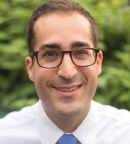In a small study of 16 patients with angiosarcoma published by Michael Wagner, MD, and colleagues in the Journal for ImmunoTherapy of Cancer, 4 patients experienced a partial or complete response to treatment with a combination of the immunotherapies ipilimumab and nivolumab, and another 2 patients maintained stable disease on the combination. In some cases, responses to treatment have been sustained for longer than 1 year, and at least one patient had their tumors disappear entirely.
The study was led by Dr. Wagner, of the Fred Hutchinson Cancer Research Center and the University of Washington. “Angiosarcoma is a rare cancer that has few effective therapy options that benefit patients for a long time,” he explained. “If there’s a subset of patients—and it seems like there is—who will have a durable response with immunotherapy, these patients would hopefully live longer and have a good quality of life.”

Michael Wagner, MD
More About Angiosarcoma and the DART Trial
With only about 400 new cases reported in the United States each year, angiosarcoma is a rare tumor that usually develops in the skin and tends to be highly aggressive. Once it has metastasized, it is typically treated with chemotherapy, but the cancer’s response to that treatment is usually not long-lasting, and angiosarcoma has a high mortality rate. Isolated reports of angiosarcoma tumors responding to immunotherapy have come out of other clinical trials, but this work represents the first prospective trial of immunotherapy in the disease.
The work was done as part of the innovative DART (Dual Anti–CTLA-4 & Anti–PD-1 blockade in Rare Tumors) trial, a federally funded basket trial examining the combination of ipilimumab and nivolumab for a wide range of rare cancer types.
Through DART, this drug combination has been tested in 53 cohorts of patients with rare cancers, with testing still underway in 10 of those cohorts. The trial has enrolled 773 patients thus far and is approaching its ultimate goal of 818 patients.
“Outside of DART, the angiosarcoma study probably would have taken years to get going,” Dr. Wagner said. “Adding it to DART helped expedite getting these results.”
Angiosarcoma Cohort Resullts
Dr. Wagner’s team treated 16 eligible patients with metastatic or unresectable angiosarcoma with the immunotherapy combination— ipilimumab at 1 mg/kg intravenously every 6 weeks plus nivolumab at 240 mg intravenously every 2 weeks.
The objective response rate for the combination was 25%. Six saw their tumors shrink—three of these patients met the criteria for a partial response to treatment, and one met the criteria for a complete response. Two additional patients had tumors that were stable after starting treatment. These two patients still remain on treatment with stable disease. Among the five patients on the trial with primary cutaneous disease of the face or scalp, three (60%) improved with treatment. Six-month progression-free survival was 38%.
Treatment toxicity in this group of patients was comparable to the toxicity seen in other trials with the ipilimumab and nivolumab combination in sarcoma. Among these patients, 75% reported treatment-related adverse events, 68.8% reported an immune-related adverse event, and 25% reported treatment-related adverse events of grade 3 or greater.
The study authors concluded, “The combination of ipilimumab and nivolumab demonstrated an objective response rare of 25% in angiosarcoma, with three of five patients with cutaneous tumors of the scalp or face responding. Ipilimumab and nivolumab warrant further investigation in angiosarcoma.”
Disclosure: This work was supported by the National Institutes of Health, the National Cancer Institute, and Bristol Myers Squibb. For full disclosures of the study authors, visit jitc.bmj.com.

